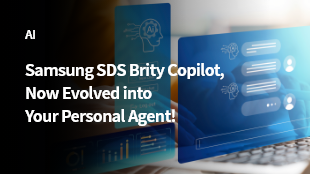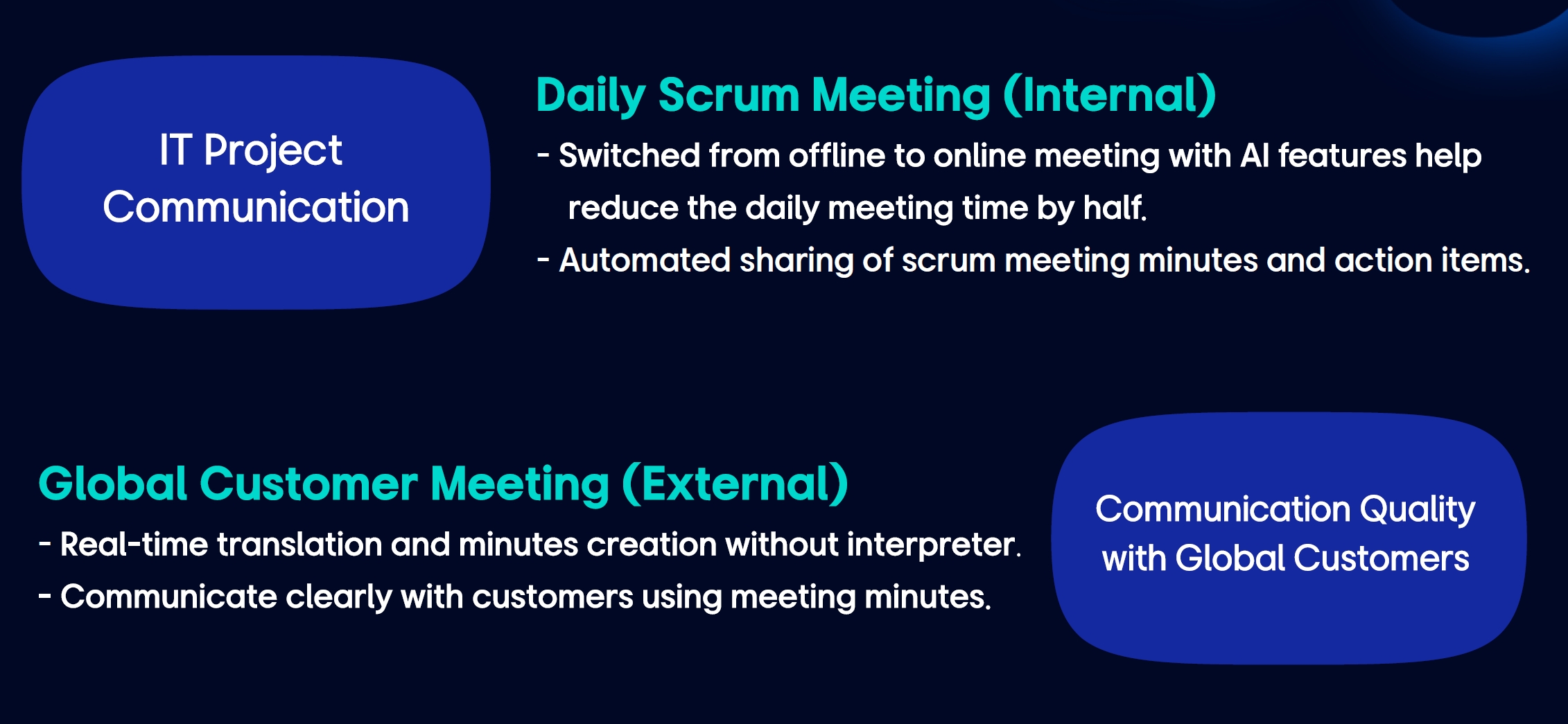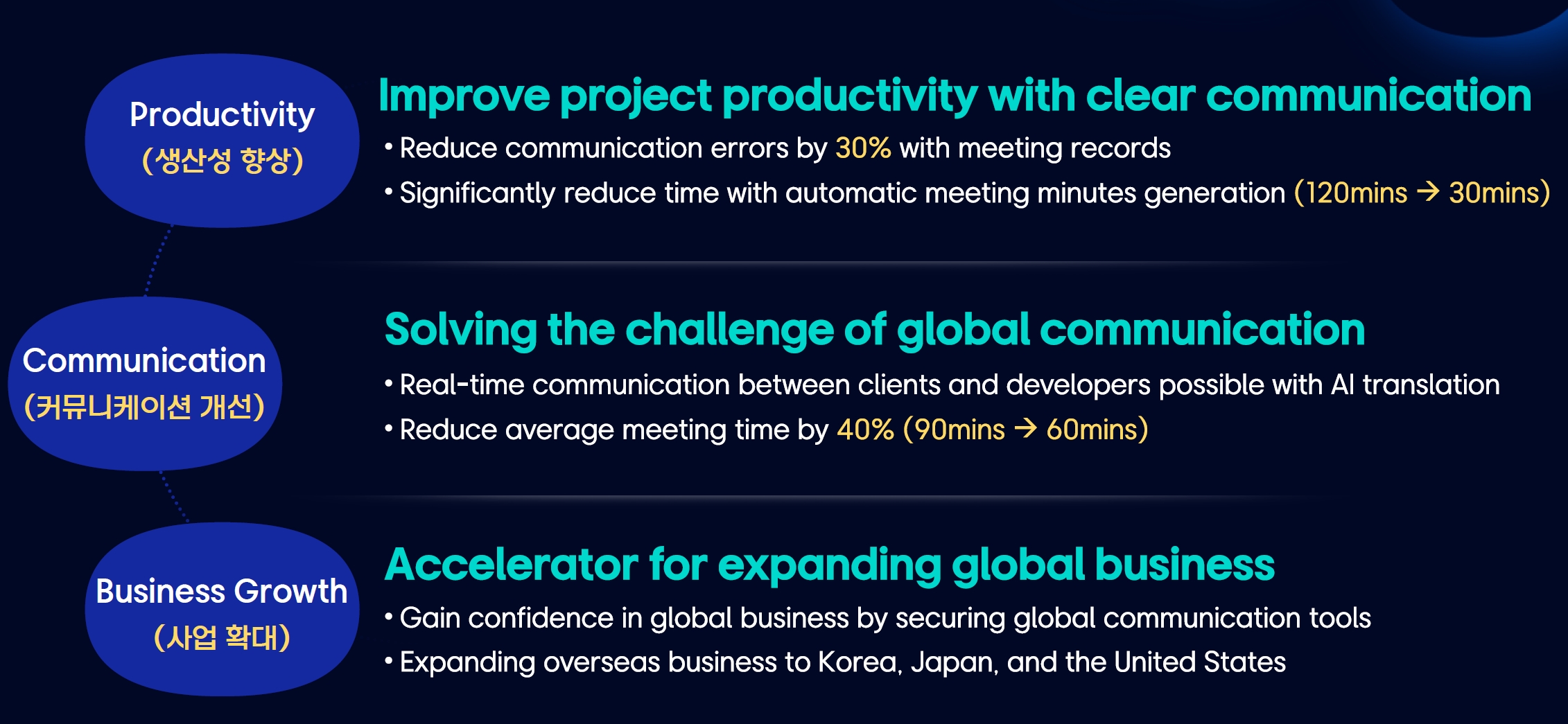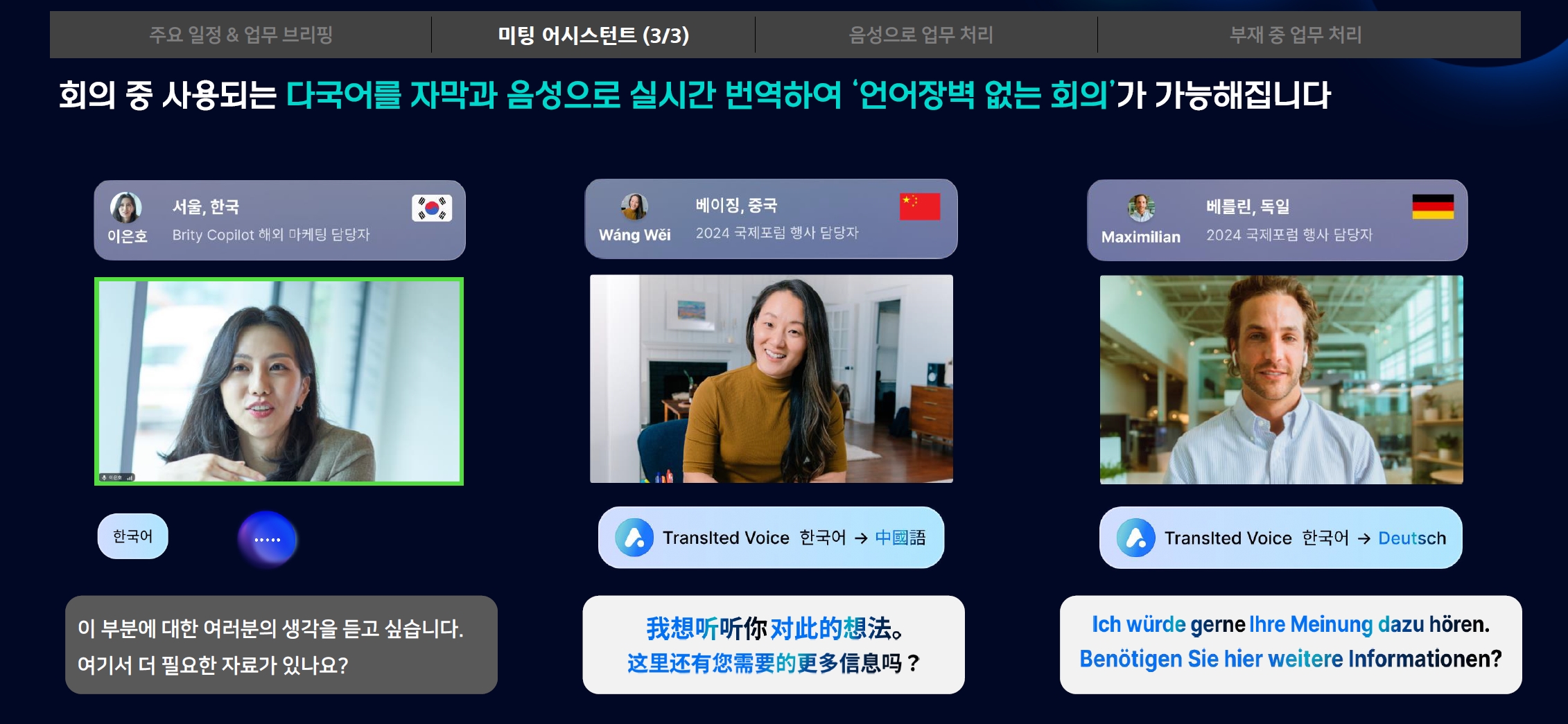Brity Copilot, Now Evolved into Your Personal Agent! (Featuring the case of CMC Global in Vietnam)

Samsung SDS provides the “Brity Works” suite, which includes core collaboration tools—Mail, Messenger, Meetings, and Drive—widely used across Samsung affiliates and many other enterprises. In April 2024, Samsung SDS launched “Brity Copilot,” applying generative AI to its collaboration suite. While the market offers countless collaboration solutions, only a few, such as Microsoft, Google, Zoom, and Samsung SDS, deliver a true all-in-one solution with integrated mail, messaging, meetings, and a copilot. Brity Copilot, powered by the internally developed generative AI platform “FabriX,” has already been adopted by over 100 companies, transforming work processes for their employees.
Samsung SDS has internally analyzed usage and effectiveness, revealing that users leverage Brity Copilot on average 14 times per day. This demonstrates that even at the early stage of adoption, employees are able to seamlessly utilize generative AI features without any additional training.
In addition, the impact extends across various day-to-day activities. For example, meeting minutes creation time was reduced by 70% (from 100 minutes down to 30 minutes), and email draft and review time decreased by about 66% (from 3 minutes to 1 minute). This translates to an average monthly time savings of 4.9 hours per person. For a company with 500 employees, this equates to a total monthly efficiency gain of 2,450 hours.
How do real users feel about their experience with Brity Copilot? Let’s look at the experience of CMC Global, a leading IT company in Vietnam.
CMC Global: Work Innovation with Brity Copilot
CMC Global is a subsidiary of the Vietnam-based CMC Group, with around 3,000 IT engineers worldwide. Their services range from digital transformation including AI, data analytics, cloud, and low code, and managed service covering IT infrastructure, cloud and application managed services. The company also provides enterprise platform service to provide SAP and Salesforce enterprise platforms, and software development service. In particular, software development is its flagship focus—it supports software development, demonstrating its capabilities in many countries including Vietnam. However, CMC Global faced two major challenges in IT projects and software development processes.
The first challenge was “internal communication” while executing a project. To illustrate, Steven, a software engineer, is acting as the project manager. Teams from multiple locations, including Vietnam and Korea, are working together on the project and, even within Vietnam, teams are working from different offices. While working at the office in Vietnam, Steven attends various internal meetings related to daily scrum*, SoW (Scope of Work), and business analysis. It is important to coordinate opinions and ensure common understanding among attendees in internal meetings. However, complaints have been raised about the lack of actual working time due to excessive meetings. Also, language barriers pose significant challenges to drafting meeting minutes, building consensus among participants, and coordinating role assignments
Scrum: An interactive and incremental development methodology for project management, it is one of the frameworks within Agile software development. Originally designed for software development projects, it can also be applied to software maintenance teams as well as to general project and program management.
The second challenge was “communication with clients,” which arises when communicating with clients from different countries, time zones, cultures, solutions, and domains. It is essential to clearly understand the client's requirements. In the process, however, not only technical issues but also language barriers and cultural differences become significant issues.
CMC Global formed a dedicated team to find solutions for two use cases: daily project scrum meetings and global client meetings. Goals were to cut down internal meeting time, boost communication, and clearly understand client requirements. To this end, the team reviewed various online meeting tools and conducted comparative tests. Samsung SDS’s enterprise AI solutions, Brity Meeting and Brity Copilot, were finally selected.
 [Figure 1] CMC Global’ Use Case of Generative AI Adoption (Source: Samsung SDS)
[Figure 1] CMC Global’ Use Case of Generative AI Adoption (Source: Samsung SDS)
Then, what kind of results or benefits have Brity Meeting and Brity Copilot delivered? Previously, CMC Global worked with professional interpreters who have both linguistic and technical expertise for global business, but it was indeed challenging to utilize interpreters in all projects due to cost and supply constraints. After adopting Brity Copilot, communication errors fell by 30%, and the time required to generate meeting minutes decreased to about 25% of the previous duration through auto-generation of meeting minutes, greatly increasing efficiency.
Another important benefit is “the improvement of global communication.” As CMC Global is actively growing its business on a global scale, Brity Copilot enabled seamless meetings with clients worldwide. With live captions and auto-translation, the solution generates meeting minutes automatically after each meeting. These features reduce the time and effort spent on exchanging opinions and obtaining confirmations between customers and CMC Global, resulting in the average meeting duration being shortened by approximately 40%, from 90 minutes to 1 hour.
CMC Global has utilized Brity Copilot as a communication tool for both internal use and interactions with customers, which has helped them gain great confidence in conducting global business across countries such as Korea, Japan, and the United States
 [Figure 2] CMC Global – Key Improvements via Brity Copilot (Source: Samsung SDS)
[Figure 2] CMC Global – Key Improvements via Brity Copilot (Source: Samsung SDS)
The Future of Brity Copilot
By improving communication, Brity Copilot enhances productivity and ultimately drives business growth. However, Samsung SDS goes beyond the status quo and prepare for what’s next by actively responding to technological changes.
The emergence of generative AI and large language models (LLMs) transform the way of working. Simply put, “Language User Interface (LUIs),” which lets users interact through human language, is emerging as an alternative to the traditional Graphic User Interfaces (GUIs) such as command inputs or mouse clicks. In this context, the initial stage of LUI, “Copilot,” functioned as an assistant, supporting task execution based on the user's inputs and instructions. So, what will the future of generative AI look like? There are various predictions, but Samsung SDS is focusing on the “Autonomous Agent.” This is also an area of focus for Silicon Valley and big tech companies. The future of generative AI is expected to move beyond the current approach where users simply ask questions or give one-sided instructions to an LLM, toward a model where they interact with Autonomous Agents that have specific goals and make decisions on their own.
What is the difference between an Autonomous Agent and a traditional Copilot? The Autonomous Agent can perform tasks independently and autonomously within a specific domain, and has the ability to understand situations and contexts and to reason accordingly, enabling more efficient task execution as the need for user intervention is reduced. Also, while the Copilot had a one-dimensional function of generating responses to individual commands or requests, the Autonomous Agent can handle more complex, multi-step instructions or requests involving two or three or more combined tasks.
By incorporating Autonomous Agent functionalities, Samsung SDS Brity Copilot is evolving into a “Personal Agent,” which is expected to secure meaningful differentiation in the market.
How does the Personal Agent operate? When a user makes a request to the Personal Agent, it first collects the appropriate data, then plans the methods and sequence of the tasks to be performed, and finally executes the tasks. These three steps are repeated until the objective is achieved. The most important element of preparation is data. In practice, workplace generates a vast amount of information daily. Ultimately, the success will depend on whether this information can be transformed into data that the agent can utilize.
Brity Copilot secures a wide range of business data. Recent work data such as emails, messengers, and documents is collected in real time using a graph-based approach with “RAG (Retrieval-Augmented Generation)” technology. In addition, business system data within the enterprise, such as HR and CRM, is secured through API-integrated plug-in. This allows the data to be utilized in accordance with the user’s access permissions.
In general, companies hold more offline meetings than online meetings, but only when someone prepares the meeting minutes can the content of the offline meetings be captured as data and utilized. Brity Copilot’s upcoming “offline meeting record” feature will help users reduce this effort and focus more on the meeting itself. In small face-to-face meetings or meetings without laptops, users can use mobile devices to record the meeting content. Also, the feature distinguishes speakers within the same space, allowing the meeting content to be organized by individual speaker. Especially, while recording meetings, users can simultaneously utilize real-time captioning and translation features. This feature also supports recognition of technical or specialized terms and includes enterprise-specific security functionalities such as preventing mobile screen capture. Such meeting records are naturally integrated with email and messenger platforms, providing a seamless user experience.
In addition, the transcription feature, which currently supports only English and Korean, is planned to be expanded to cover 10 languages, enhancing support for meetings with customers or partners from non-English speaking countries.
Once usable data is prepared, Personal Agent enables a more personalized, proactive, and autonomous work experience. The Personal Agent provides accurate and optimized responses based on each individual’s work data, autonomously assesses the work situation and context to generate or refine responses proactively, and autonomously carries out planned or required tasks without user intervention.
Let’s look at some examples of how the Personal Agent is transforming the way companies work. After arriving at work, most employees spend a significant amount of time checking their emails and schedules, as well as planning their tasks. However, the Personal Agent reviews personal data to provide “briefings on key schedules and tasks”, helping users save time and effort. Additionally, the Personal Agent provides various forms of assistance even during meetings. For example, during a meeting if a topic mentioned is selected, the Personal Agent searches for and recommends related materials. Also, if the materials are shared in the meeting, the Personal Agent recognizes the text and “automatically translates” it into the desired language.
Furthermore, in meetings where multiple languages are used simultaneously, not only subtitle translation but also voice interpretation as if an interpreter were present is provided. Therefore, even if someone speaks in Korean, employees in China and Germany will see subtitles or listen to audio translated into Chinese and German, respectively. This enables language barrier-free meetings.
After the meeting ends, the Personal Agent organizes the action items discussed during the meeting and registers them as tasks for the participants, and it also helps manage progress when needed.
 [Figure 3] Personal Agent – Meeting Assistant (Multilingual subtitles/interpretation) (Source: Samsung SDS)
[Figure 3] Personal Agent – Meeting Assistant (Multilingual subtitles/interpretation) (Source: Samsung SDS)
Now, not only in the office but also while on the move, users can handle tasks via voice through the Personal Agent. When a user receives an important email while on the go, the Personal Agent summarizes and reads it aloud. Then, the user reviews the email and carries out tasks like sending a reply or sharing documents, all through voice commands.
During periods of absence or focused work, the Personal Agent handles work requests for users. Previously, when employees received business questions or requests for document sharing during absence, they could only handle them after returning to the office. However, with the Personal Agent responding on behalf of the employees, tasks can be seamlessly processed without interruption.
Conclusion
So far, we have examined several examples of how work experiences will be transformed through the Personal Agent. The important thing is that this is just the beginning, not the whole story. By 2024, Samsung SDS will have established the foundation of a “Digital Workspace” that enables the Personal Agent to effectively collect and utilize data generated across diverse work environments. In 2025, Samsung SDS will complete the full-fledged Personal Agent and a language barrier-free meeting service.
At work, we often receive various requests such as “Please handle this task” or “Could you take care of this assignment?” When these requests pile up all at once, have you ever wished that someone could give you a hand with your workload? Now, the Personal Agent will help you. With the Personal Agent, employees will work more efficiently, tasks will be completed faster, and above all, companies will be able to achieve greater growth. You can look forward to seeing how Brity Copilot, evolving into a Personal Agent, will transform the way both the company and individuals work.

Strategic Marketing Team at Samsung SDS
Had been in charge of digital transformation in samsungsds.com, solution page planning/operation, based on her work experiences in IT trend analysis, process innovation, and consulting business strategy, and is now in charge of content planning and marketing through trend/solution analysis for each main business sector of SDS.
-
Over the Coming Wave
- Part 2 Strategies for AI Risk Management -
Over the Coming Wave
- Part 1 AI Risk Perception and Assessment Framework - The Rise of Generative Enterprises: Reshaping the Future of Business With Generative Technologies
- ESG Framework for Sustainable AI Business
- B2B Companies Transforming Into 'Generative AI-Centered'